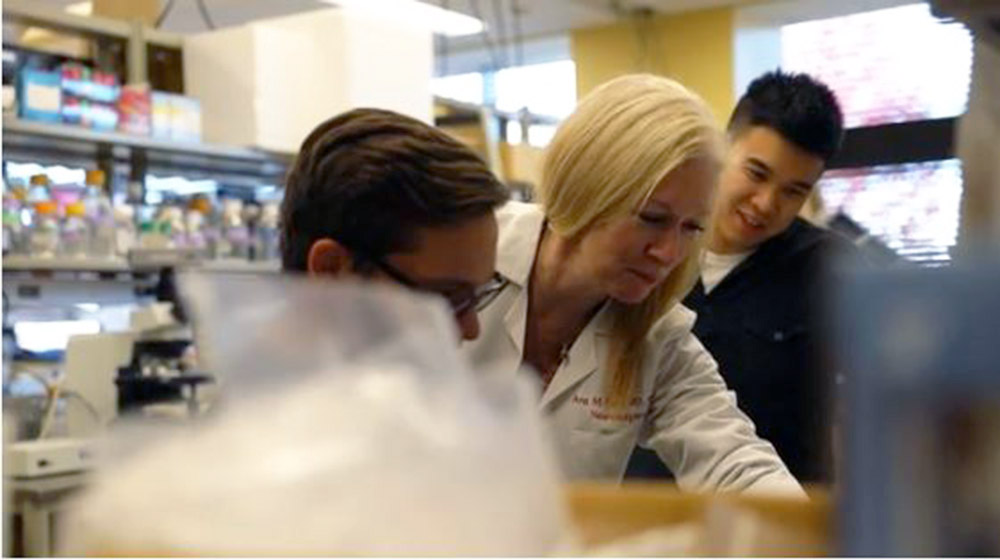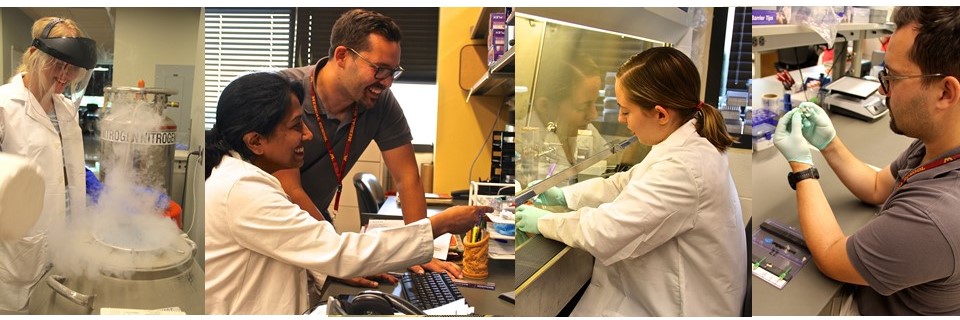Parr Lab

As a board-certified neurosurgeon and head of the Parr Laboratory, Dr. Ann Parr brings a unique perspective to her work in human spinal cord injury (SCI). The overall goal of her lab’s research is to develop new therapies for SCI. The lab team is most interested in studying the unmet needs of those with chronic spinal cord injury as any advances would have significant impact. The long-term goal is for their research to culminate in treatments that are clinically available.
With their long-term goal in mind, the Parr Laboratory team has discovered novel methods of producing human autologous, regionally specific spinal neural progenitor cells and is exploring how these mediate functional recovery after transplantation into an injured spinal cord. There is increasing evidence, however, that these cells alone may not be sufficient, requiring a multi-modal approach.
To that end, the lab partners with the Spinal Cord Society, a nonprofit organization that has provided equipment, knowledge, and expertise. The partnership has enabled the Parr Lab to develop several strategies. One example is using a novel scar ablation technique in combination with the lab’s human autologous, regionally specific spinal neural progenitor cells, a unique scaffold developed in collaboration with the U of M’s McAlpine Research Group, and transcutaneous spinal cord stimulation to examine interactions among these therapies in a rodent model.

- Patil N, Walsh PJ, Carrabre K, Holmberg EG, Dutton JR, Lavoie N, Parr AM. Regionally specific human pre-oligodendrocyte progenitor cells produce both oligodendrocytes and neurons after transplantation in a chronically injured spinal cord rat model after glial scar ablation, J Neurotrauma, epub 2020 Oct 27
- Walsh P, Truong V, Nayak S, Saldías Montivero M, Low WC, Parr AM, Dutton JR (Co-senior authors). Accelerated differentiation of human pluripotent stem cells into neural lineages via an early intermediate ectoderm population. Stem Cells. 2020 Nov;38(11):1400-1408. doi: 10.1002/stem.3260. Epub 2020 Aug 19. PubMed PMID: 32745311
- Peña Pino I, Hoover C, Venkatesh S, Ahmadi A, Sturtevant D, Patrick N, Freeman D, Parr A, Samadani U, Balser D, Krassioukov A, Phillips A, Netoff TI, Darrow D. Long-Term Spinal Cord Stimulation After Chronic Complete Spinal Cord Injury Enables Volitional Movement in the Absence of Stimulation. Front Syst Neurosci. 2020;14:35. doi: 10.3389/fnsys.2020.00035. eCollection 2020. PubMed PMID: 32714156; PubMed Central PMCID: PMC7340010
- Joung D, Lavoie NS, Guo SZ, Park SH, Parr AM*, McAlpine MC* (Co-Senior Authors). 3D Printed Neural Regeneration Devices. Adv Funct Mater. 2020 Jan 3;30(1). doi:10.1002/adfm.201906237. Epub 2019 Nov 8. PubMed PMID: 32038121; PubMed Central PMCID: PMC7007064
- Darrow D, Balser D, Netoff TI, Krassioukov A, Phillips A, Parr A, Samadani U. Epidural Spinal Cord Stimulation Facilitates Immediate Restoration of Dormant Motor and Autonomic Supraspinal Pathways after Chronic Neurologically Complete Spinal Cord Injury. J Neurotrauma. 2019 Aug 1;36(15):2325-2336. doi: 10.1089/neu.2018.6006. Epub 2019 Mar 6. PubMed PMID: 30667299; PubMed Central PMCID: PMC6648195
- Joung D, Truong V, Neitzke CC, Guo SZ, Walsh PJ, Monat JR, Meng F, Park SH, Dutton JR, Parr AM*, McAlpine MC* (Co-senior authors). 3D Printed Stem-Cell Derived Neural Progenitors Generate Spinal Cord Scaffolds. Adv Funct Mater. 2018 Sep 26;28(39). doi: 10.1002/adfm.201801850. Epub 2018 Aug 9. PubMed PMID: 32595422; PubMed Central PMCID: PMC7319181
- Patil N, Truong V, Holmberg MH, Lavoie NS, McCoy MR, Dutton JR, Holmberg EG, Parr AM. Safety and Efficacy of Rose Bengal Derivatives for Glial Scar Ablation in Chronic Spinal Cord Injury. J Neurotrauma. 2018 Aug 1;35(15):1745-1754. doi: 10.1089/neu.2017.5398. Epub 2018 Apr 19. PubMed PMID: 29373946; PubMed Central PMCID: PMC6033306
Dr. Nandadevi Patil
Anne Huntemer-Silveira
Angelique (Angie) Bernik
Yi Wen Chai
Amanda Vegoe
- “Modulation of BDNF Signaling by the Neurosecretory Protein VGF Mediates Spinal Neuroplasticity,” Department of Defense, 08/01/2020 – 07/31/2024. The goal of this project is to examine the relationship of TLQP-62 and BDNF in spinal neuroplasticity and how it is regulated during the transition to chronic pain
- “Autologous Oligodendrocyte Progenitor Cells for Transplantation in Spinal Cord Injury,” 2011-indefinite. The goal of this project is to develop autologous, clinically relevant human oligodendrocyte progenitor cells and to perform pre-clinical testing in a rat model of spinal cord injury
- “Teaching Transplanted Neurons to Function,” Minnesota Spinal Cord Injury and Traumatic Brain Injury Grant Program, 07/01/2018 – 06/30/2021. The goal of this project is to transplant our sNPCs into a rat model of chronic SCI in combination with transcutaneous epidural stimulation
- “Optogenetics to Stimulate the Corticospinal Tract,” Minnesota Spinal Cord Injury and Traumatic Brain Injury Grant Program, 07/01/2018 – 06/30/2021. The goal of this project is to stimulate the motor cortex of our rat model of SCI to determine whether this will promote axonal growth and neuroplasticity
- “iOptimize,” Minnesota Spinal Cord Injury and Traumatic Brain Injury Grant Program, 07/01/2018 – 06/30/2021. The goal of this project is to extend our experience with epidural stimulation in humans (ESTAND) to map the human spinal cord
- “ESTAND,” Minnesota Spinal Cord Injury and Traumatic Brain Injury Grant Program, 07/01/2018 – 06/30/2021. The goal of this project is to utilize epidural stimulation to improve functional outcomes after chronic spinal cord injury.
- McAlpine Research Group — 3D printing of spinal organoid scaffolds
- Spinal Cord Society — electrical stimulation project (TANES) and glial scar ablation protocol
- Optogenetics core
- Spinal Cord Society
- Minnesota State Grant
- University of Minnesota Foundation
- The Morton Cure Paralysis Fund
- Department of Defense
- U of M researchers create important new technique for manufacturing human neurons, partner with co-developers turned bio-entrepreneurs to commercialize the new process
- Regenerative Medicine Minnesota Grant Video
- U of M, Hennepin Healthcare study gives hope to those told they would never walk again
- University of Minnesota Researchers Created 3D-printed Implant that Restores Function in Spinal Cord
- U of M may have spinal injury breakthrough with 3D printing
- University of Minnesota reports breakthrough in 3-D printing for spinal cord repair
- New 3D-printed device could help treat spinal cord injuries
- Spine surgeon leader to know: Dr. Ann Parr of UMN Medical School